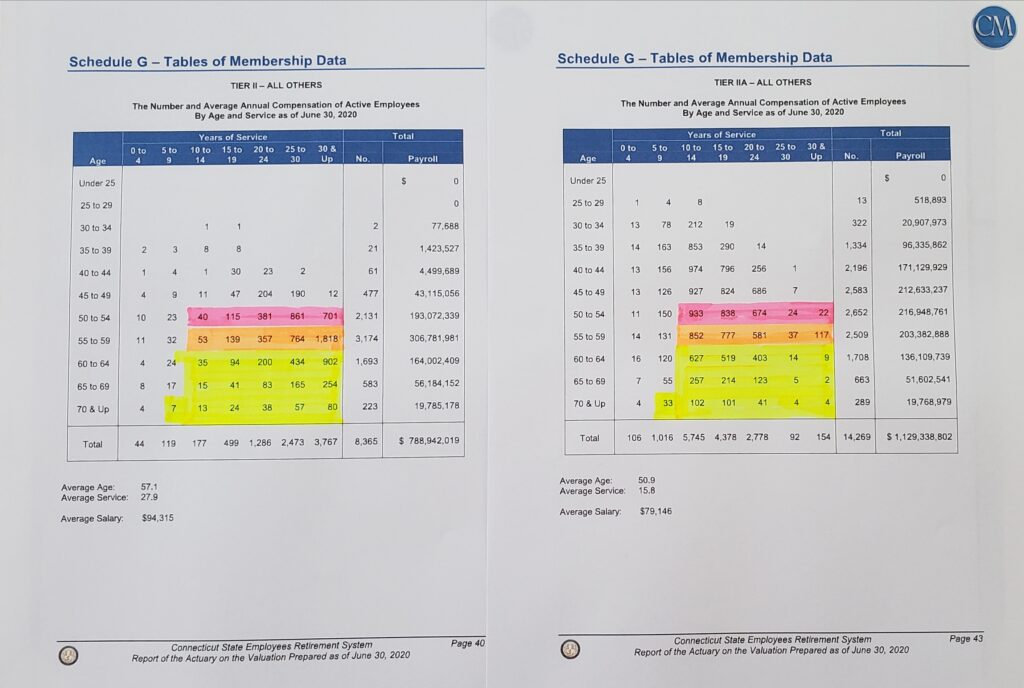
Gov. Lamont’s tentative agreement with Connecticut state labor unions is designed to prevent a state employee retirement wave over the next three months. Lamont is offering huge wage raises and bonuses to induce employees to stay on the job.
Ironically, in trying to prevent the current retirement surge, Lamont would be creating a much bigger and costlier wave in less than two and a half years.
In 2017, former governor Dannel Malloy created the current retirement dynamics. Malloy negotiated a wage agreement with no raises for two years, followed by two years of healthy 5.5% wage hikes. This forced employees to stick around. Now, employees have collected that cash.
Why should they stay around now? That’s not the only problem Lamont faces.
Not only did Malloy back-load the goodies, but he backloaded a strong kick in the rear end to propel employees into retirement. Employees who don’t retire by this coming June 30th will have to wait 30 months for the first cost-of-living increase to their pension benefits compared to the normal 12-month wait. Heard anything lately about inflation? Also, they will have to pay twice as much for their health insurance.
One wonders why Malloy did this, other than a narcissistic desire to retire in glory by kicking the can down the road — the “can” being desperately needed reforms to overgenerous state employee compensation (5th highest of the 50 states, according to the most recent study) — reforms like the COLA “holiday” and the increased health insurance premiums, reforms that make governors unpopular.
Related Content: CT State Employees 5th Highest Paid in U.S. — Raises and Bonuses on Top of That?
Lamont doesn’t even have Malloy’s venal rationale. Lamont’s “can” will land squarely in the middle of his second term in office, if he wins re-election in November. What is he thinking?

Lamont’s three annual wage raises of about 4.5% (2.5% wage and 2.0% “step” increases) starting retroactively nine months ago will be fully baked into employees’ pensionable wage base by June 30, 2024. Wages will be about 14% higher given the compounding of those increases – and that ignores the $3,500 in front-loaded “pensionable” cash bonuses to be paid over the next three months.
With so much front-loaded pay ($3,500 in bonuses and an estimated average $2,500 lump-sum payment of retroactive pay), some employees may decide to retire within months. So much for preventing the retirement wave!
But why not stick around for less than two more years for even higher pay and an even bigger retirement benefit? If many workers do, Lamont may be forced again into even further generous payouts to prevent an even bigger and costlier retirement wave – the deal has a “re-opener” for another year of potential goodies. Preventing one wave begets another costlier one — and so on.
Now we come to the human element. Having been bribed to remain on the job for five more years by Malloy, and, then, for another two to three years by Lamont, many state employees will be quite old.
And that’s not all. Not only will the wage base be more than 14% higher in less than three years, but the population of retirement-eligible state workers will grow dramatically. Currently, there are about 8,000 state agency workers who were identified as retirement-eligible in a consultant’s study commissioned by Lamont and submitted to him a year ago.
Boston Consulting Group (BCG) was mandated to find efficiencies in the state workforce and ways to automate state services so as to reduce the number of now-soon-to-retire employees who would need to be replaced.
In less than three years, according to the latest actuarial report on the state pension fund (SERS) covering all state employees, as many as 3,000, or 40%, more state agency workers in Tier II and Tier IIA will become 55 or older and eligible at least for early retirement. Note: as many as 5,000 of all state workers in these tiers will become 55, including state employees in non-agency jobs that are also covered by SERS.
Over the past year many observers have wondered what Lamont might have been doing with BCG’s recommendations.
Related Content: Things Happen
Apparently very little, or he wouldn’t be offering such rich bribes to keep employees on the job. He should have been hiring their replacements, maintaining a process of natural renewal of the workforce.
It is better to face today’s retirement wave than one in just two to three years that would be 60% more costly, based upon 14% higher wages and a 40% bigger cohort of retirees. Lamont’s procrastination comes with an enormous cost.
The General Assembly should reject Lamont’s tentative agreement with state labor unions.
![]()
Red Jahncke is a nationally recognized columnist, who writes about politics and policy. His columns appear in numerous national publications, such as The Wall Street Journal, Bloomberg, USA Today, The Hill, Issues & Insights and National Review as well as many Connecticut newspapers.





